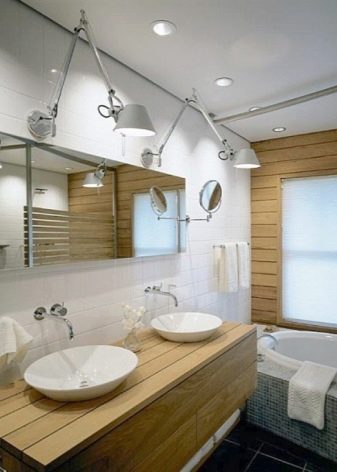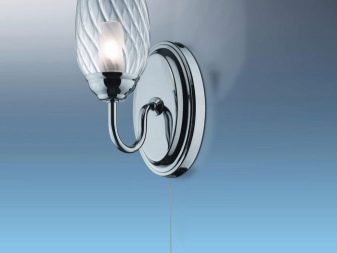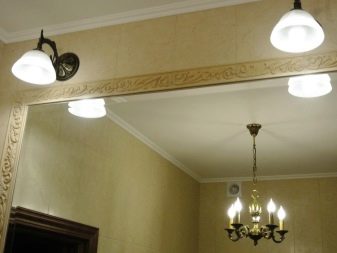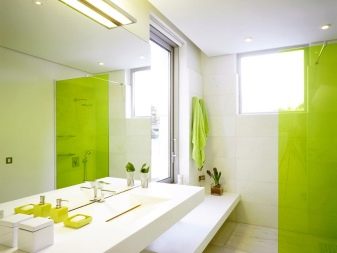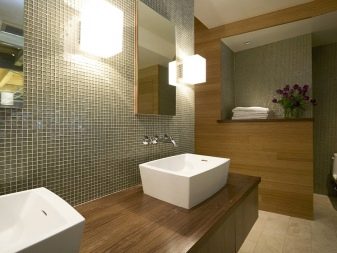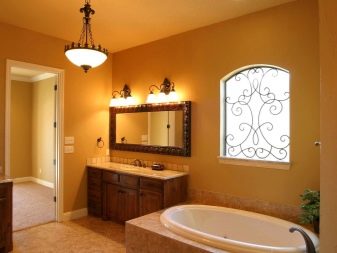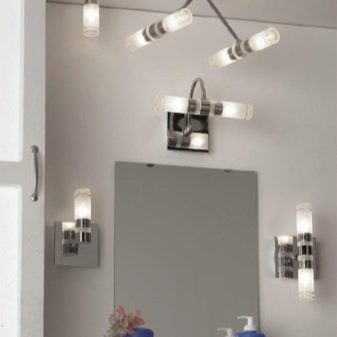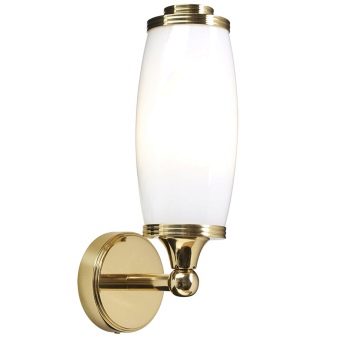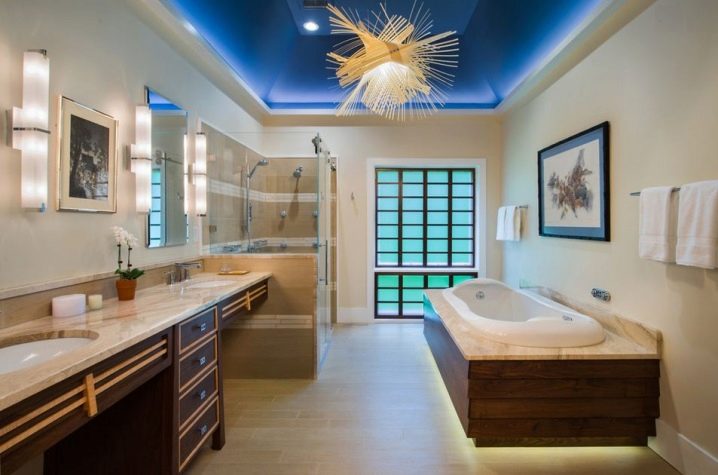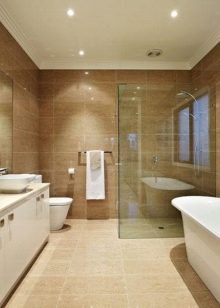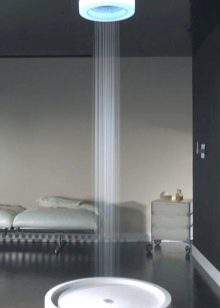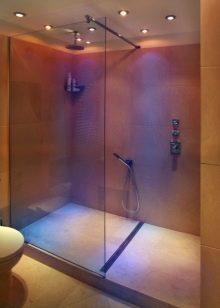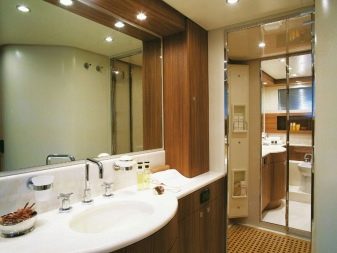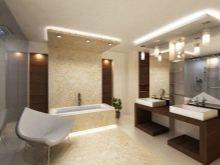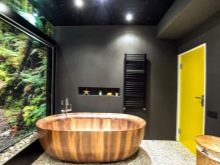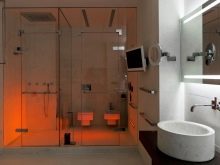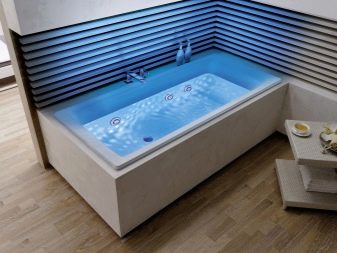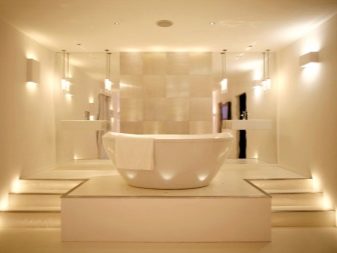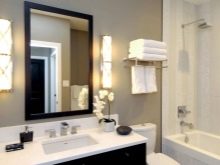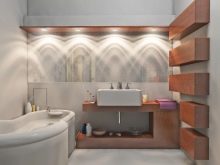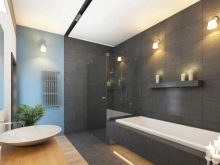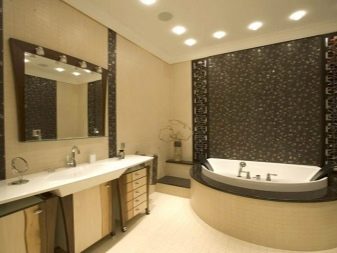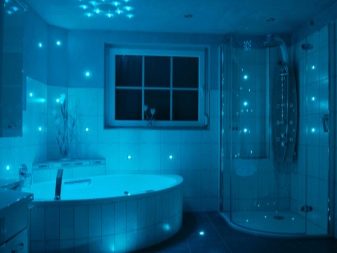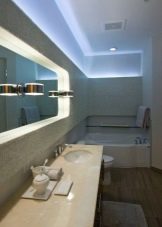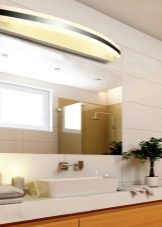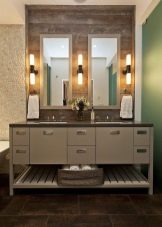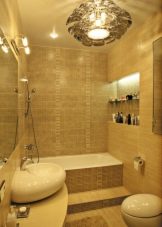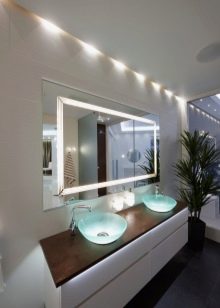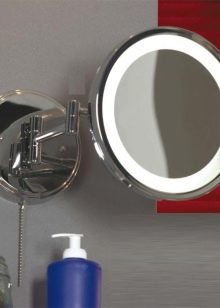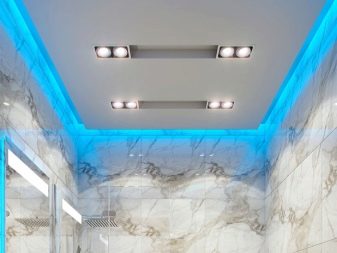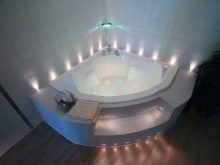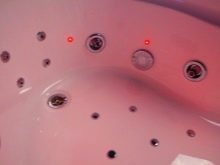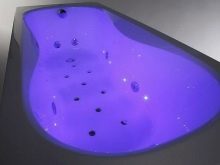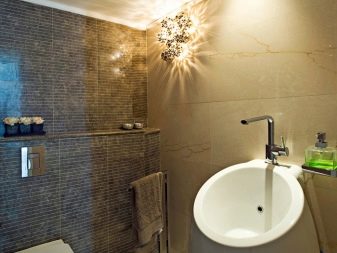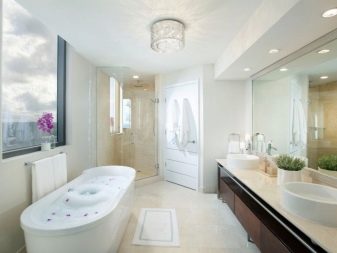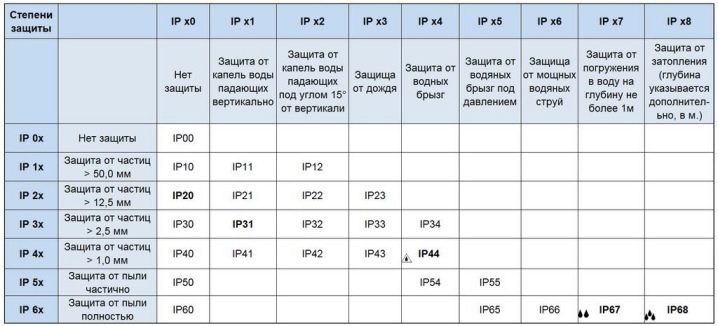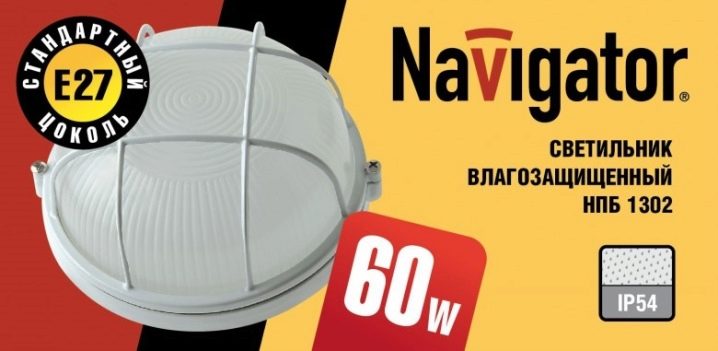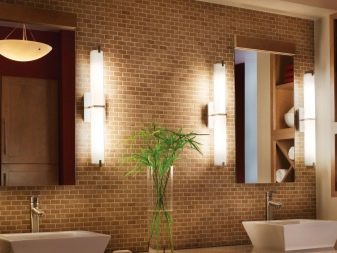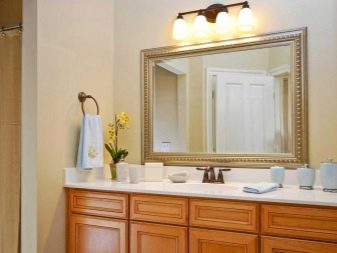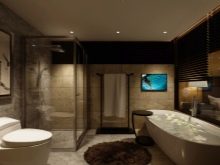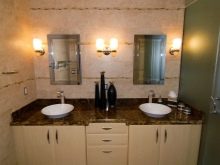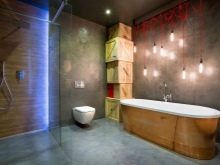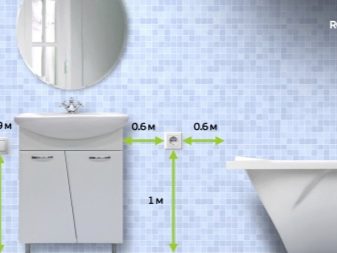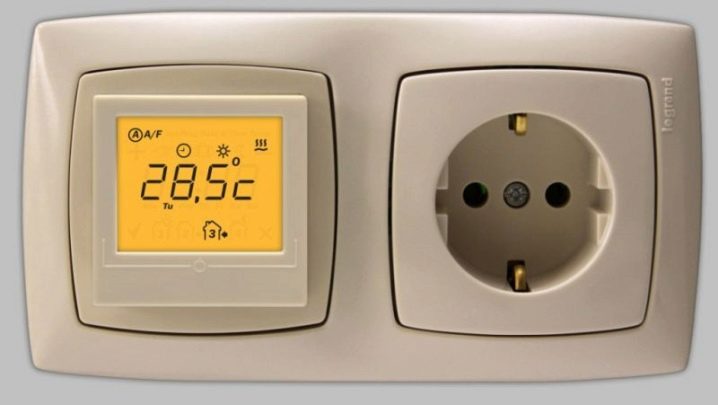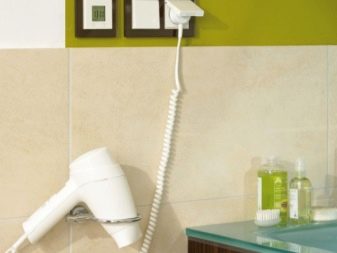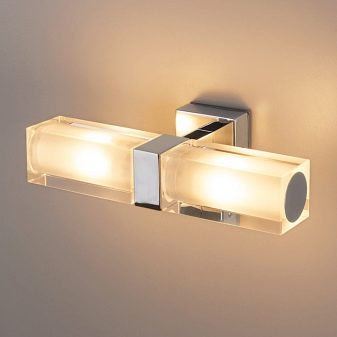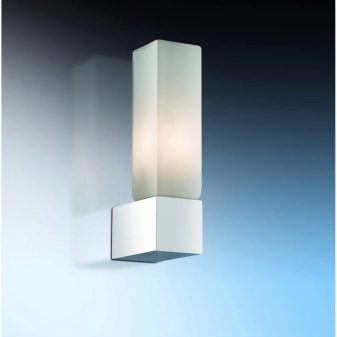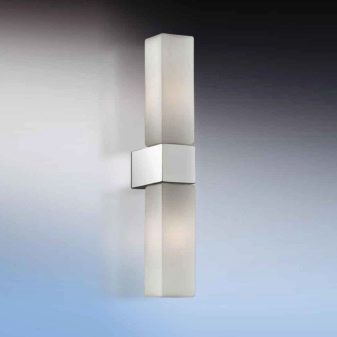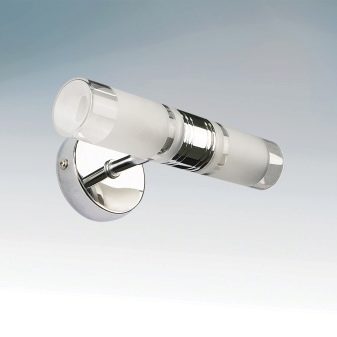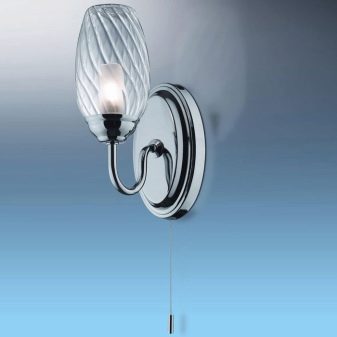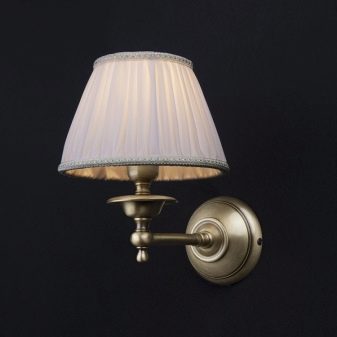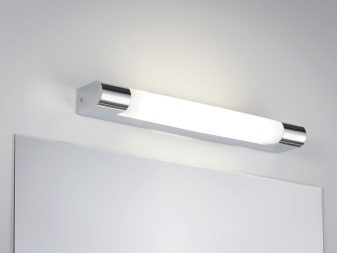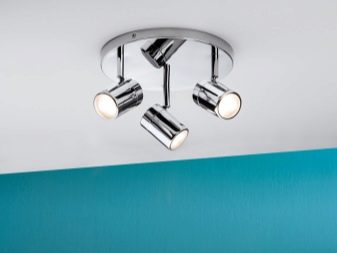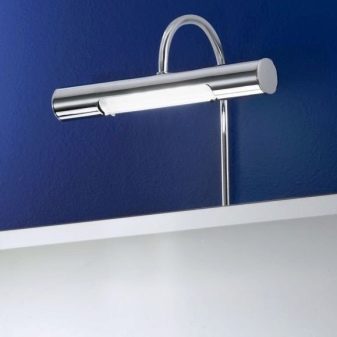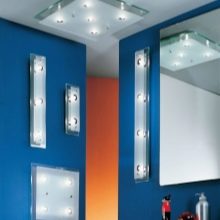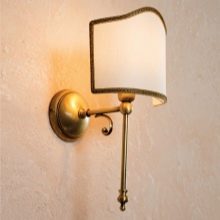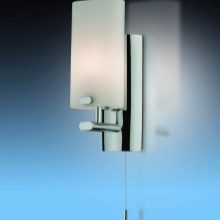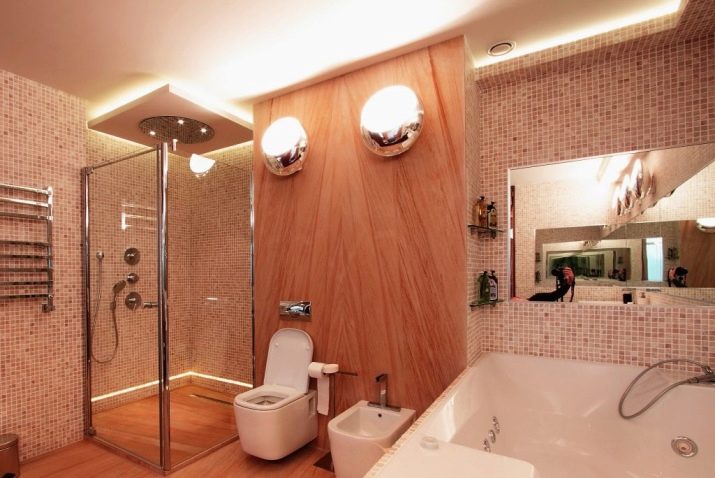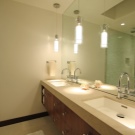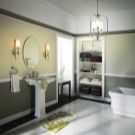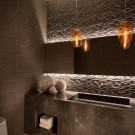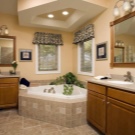Waterproof lamps for the bathroom
Lighting in the bathroom, the main place for hygiene and relaxation in the house, can be very diverse and interesting, but its organization requires a thoughtful and attentive approach. There are many design ways, this segment of the market is very rich in interesting solutions - what are the cost of fixtures that can be completely submerged in water. The main thing when choosing is the result, namely, the ability to easily take a shower or bath.
Such a room should be well and evenly lit, but the light should be made soft, and in some cases even muffled. This can be achieved in different ways: waterproof bathroom lamps are very well suited.
Features and device waterproof lamps
It may seem that the lighting for the shower looks almost the same as usual. But this is only a superficial impression.The main differences lie in the device light sources. Closed products are most common, but inside such lamps there are many additional protective elements.
These include various insulators, rubber seals and other parts that prevent the penetration of moisture and dust into the design of the product.
Often in the manufacture of such lamps and heat-resistant materials are used, because the bathroom is not only a room with high (and very unstable) humidity, but also a place of constant temperature change. Parts of fixtures are quite fragile, and metal parts are prone to corrosion. Protecting them is crucial. Otherwise, they can not only wear out quickly, but also lead to more serious problems - damage to the wiring, and even to a fire.
A feature of waterproof lamps is their closeness. The form of such devices, as a rule, is sharpened under protection from splashes and dust. There are also shockproof mechanisms that make the hull more durable. The last moment is especially relevant, since in the bathroom the lamps are often located on the walls, on the same level with the hands.With any careless movement they can be broken.
When choosing a lamp for home “saunas”, one should pay attention to its tightness and articulation of parts, as well as the strength of the body.
These factors are the features of waterproof lamps that ensure the safety of use and durability of products.
And one moment. The bathroom is often a room in which there is no natural light. In most apartments this is exactly the case, therefore the bathroom fixture will become the only source of light for some (at least, with the door closed). As a result, it is not necessary to think about the relationship and harmony of natural and artificial light spaces. In some ways, this is an advantage for interesting design solutions.
Lighting in the bathroom can be created from scratch, ”so the choice of bathroom fixtures is especially important.
Species
There are many classifications of bath lamps. Those or other manufacturers often focus on certain properties of products.
Lamps can be dust-proof, heat-resistant, moisture-proof, waterproof.Special moisture-proof (water-protective), dust-and-moisture protective, shock-proof mechanisms can be built into them.
Lighting devices can be either completely sealed, or with open parts, portable or static.
By type of lamp - LED (diode), fluorescent, neon and so on. There are both point models and scattered light sources (through overhead ceilings).
Shapes and designs may vary - some designers, for example, stylize floor lamps under the ice, creating “warm ice” cubes. Others are experimenting with rounded surfaces.
Another classification is the separation of products according to the degree of protection from various negative media and contacts - moisture, dust, physical damage.
To destination
When buying bathroom fixtures, you should immediately determine where they will be mounted. In such premises there are several zones, for each of which a different type of device will suit:
For shower
Of course, it is better not to install the lamps directly in the shower room, but if it is necessary for some reason, you should choose the most heat-resistant models. Shower - a place of contrasts, both in humidity and temperature.In addition, it is in the shower that lamps can be accidentally touched by hand or foot. It is unlikely that fluorescent bulbs or incandescent bulbs are suitable here.
The best option for the shower - spot lighting, perhaps with the help of LEDs.
But it is desirable to make the light soft, although not necessarily warm - the cold shades will also create the right mood and will be pleasantly in harmony with water.
Often in the market you can find showers with integrated lighting. If it is wired, you will have to take care of the quality of the electrical wiring in the bathroom as a whole.
For bathroom
- Entrance. Here the choice is the widest. You can take almost any lamp, better - sealed, but not always the most closed - especially if the room is large. It is worth paying attention to the heat resistance of the product. He will also have to withstand high humidity.
The light temperature can be any, but for small rooms, preference is better to give a warm gamut.
- The main zone. Here, the waterproof properties of the device should be higher. It is better to set it aside from the shower cabin, so that when spilling out of it, accidental splashes do not hit the lamp. Light temperature is selected depending on the style of the room, design.Cold light lamps are suitable for high-tech interiors and warm notes for baths decorated with flower arrangements.
In the design of the bathroom itself
Only waterproof models are suitable for swimming. Note that the light will be refracted and diffused. Cold lamps are used more often.
For a room with high ceilings, all noted recommendations are also relevant - the microclimate is formed in the room as a whole. For such rooms suitable spotlights, LEDs.
If a staircase or a straight corridor leads to the bathroom, it is advisable to combine the two interiors with a single light palette. It will be possible to turn on the light everywhere, but it is better to install the “entrance” lamp in the corridor - it will not suffer from increased humidity and temperature, but will give approximately the same effect as if the device were placed directly in the bathroom.
By way of placement
The range of bathroom fixtures, of course, is only a small segment of the lamp market, but the choice is quite large. It is necessary to leave the "brackets" option with an ordinary incandescent lamp, located on the ceiling or above the entrance door.An interesting but not very suitable idea with a large chandelier in the middle of the room should be excluded.
Then conditionally all the lamps in this category can be divided into five groups.
Ceiling
The classic version is the technological continuation of the solution with the incandescent lamp mentioned. The advantage of such products is that they can give the room additional designer chic and color, and also make the light soft, uniform - and variable.
With the help of such lamps it is possible to divide the bathroom into several light zones - a wash basin, a shower and others. Among the minuses - the need to maximize the moisture-proof properties of lighting devices, because the ceiling products are subject to all risks inherent in the room. Steam, along with high temperature, constantly rise up to them.
Such lamps should be sealed, moisture-proof and heat-resistant.
With high ceilings, these devices are protected from accidental water ingress - in the form of splashes.
Outdoor
Rare enough option, but it gradually becomes very popular. This very radical solution for a bathroom requires a very thorough approach in terms ofsecurity. However, a dust and moisture protective, heat-resistant body of such products may well provide it. There are very interesting portable options available - this is one of the unique advantages of such products.
There are models, stylized under the ice ("blocks of ice"), having geometric and sculptural outlines, and other options. In some cases, light sources are mounted directly to the floor.
As a rule, floor lamps are used in large rooms, quite often - in country houses or cottages. Only a large space allows them to reach their full potential, which makes the room more light.
The use of such lamps in small bathrooms is fraught with the appearance of various highlights, brightness, which will be annoying, and "weighting."
Wall mounted
Often this fluorescent lamps, dust and moisture proof products. Can be diode, point. Wall lights must be protected from physical damage and have good anti-shock properties, as they are often exposed to accidental touches, especially in small showers.
Such devices provide an ample amount of light, but (due to the specifics of their location) can prevent the creation of maximum comfort, unpleasant discord in the interior with batteries, hangers and other necessary elements of the room. It is also worth adding that the waterproof properties of wall lamps are sometimes noticeably inferior to the properties of other types of products - due to their design and location. Yes, and spray from the shower often fall on the wall, rather than the ceiling.
It is better to use such lighting devices away from the shower and sink (as an option - near the front door). These lamps will look more profitable in large rooms, but in this regard, their use is not so categorical. Even in a small bathroom (if you choose a suitable place for such a lighting device) you can simultaneously solve several problems at once - to achieve bright, uniform lighting.
Mortise and embedded
Used, for example, in overhead ceilings. Recessed luminaires themselves may not differ in increased water-protective properties, but they still need heat resistance.
Most often, mortise, recessed into other designs fixtures belong to the category of powerful LED products that allow you to bring light through artificial obstacles. As a result, the main disadvantage of such lamps is the inability to actively control the light. As an option - the use of dimmer (electronic dimmer) or other technological solutions, it will control the brightness of the lighting.
Submarine
In conventional bathrooms, such devices are rarely used, more often they can be seen in the pools. In the presence of a large bathroom can be an interesting designer find. Must be waterproof, have very good shockproof properties.
Degree of protection
One of the main points that should be paid attention to when choosing a product is the degree of its protection from various external factors. Light technologies have now advanced far enough, so that you can find products for sale that are practically unaffected by household loads.
The security of a luminaire against certain factors is a measurable and fairly clear indicator. It is called IP (Index of Protection).
The key ones in it are the first two digits, indicating the degree of protection from dust (ingress of solid particles) and moisture resistance.
The first digit can vary in the range from 0 to 6 - in order of increasing dust protection. 0 - there is none as such. At unit items can be touched. Such a device is not yet protected even from insects. Further indicators are 12 mm, 2.5 mm and 1 mm. The figure 5 speaks of high dust protection, and at 6 - practically nothing will get into the device.
In terms of water resistance, the range usually includes numbers from 0 to 8.
- 0 is the absence of any protection from moisture.
- 1 - ensures operability when hitting vertical drops.
- 2 - the quality of the luminaire is maintained when moisture gets at an angle of 15 degrees.
- 3 - already at 60 degrees (conditional rain).
- 4 - a fairly universal option (spray can fall on such a lamp from either side).
- 5 - even jets of water will not cause harm to such a device.
- 6 - it is possible to influence sea salt.
- 7 - will not break if immersed to a depth of one meter. Suitable for fixtures that are installed directly in the bath.
- 8 - the lamp can be used for a long time and at almost any depth possible in living conditions.
For different baths suitable fixtures with different indicators of security, but the key point is the separation of the bath into zones. Consider the classic version. Directly in the bath and at a distance of no more than 10 cm from it, the IP should be at least 67 (for convenience, it is worthwhile to combine the numbers into a number). At a distance of about half a meter - 44. Further, even the use of fixtures with IP 21 is possible.
Often in IP can be found and the third digit, indicating the impact resistance of the product. This indicator is graded according to the same logic as the previous ones. This is not the main, but also an important criterion when choosing a product. However, even strong parts (for example, metals in a bath) can suffer from corrosion. This means that the impact resistance in such conditions in some cases may decrease with time.
The main thing is that water and dust do not get inside the lamp, and also that it does not break - otherwise the first two points will not matter. Whatever the IP, it is better to carefully handle the products, try to avoid contact with moisture, especially splashes.
A good way to increase the longevity of luminaires is to air the bath regularly.After the shower, always leave the door open.
It is worth noting another interesting detail. Moisture-resistant lamps designed specifically for baths, as a rule, have greater durability than other similar products. They can be effectively used in other rooms. In climates with high humidity and abundance of insects, such products are particularly useful and relevant.
Optional accessories
The quality of electrical wiring in the bathroom is vital in the direct sense of the word, therefore, when organizing lighting, special attention should be paid to wires. Better if they are in the walls. The less wires are in open spaces, the safer the room, especially in case of unavoidable contact with water.
If in a bedroom or living room an unsuccessful “communication” with a closed cable is limited to just a sense of discomfort, then in the bathroom it can lead to serious injuries, and even death.
First and foremost advice - entrust conduction of cables to electrical specialists and do not save on the quality of materials or quality of work. If there is a wire left after such work, there is clearly something wrong.In bathrooms, only hidden wiring is possible - according to official rules. And no wires, especially in the "sleeves" and metal shells. Even the sockets in the bathroom should have special specifications - usually IP44, as well as a special cover.
In addition, in the bathroom are usually used more and special mechanisms of protection against possible interruptions and closures - grounding, leveling, and so on. This is especially important if the bathroom uses various appliances that receive energy from electricity: for example, washing machines.
With a careless attitude to this issue, even in the simplest situation (for example, when a hair dryer is connected) a short circuit may occur.
A separate moment - the switch. It should also be dust and moisture proof. It must be very securely attached to the wall, otherwise all its advantages will lose their meaning. It is also better not to save here, especially since the price of such products is relatively low, and the choice is wide: the specifications from IP44 to IP66 are most often on sale.
And a few more words about the location of the switch. In many cases, it is outside the bathroom, but this does not guarantee safety during operation.The fact is that when you turn off the light (for example, when leaving the bathroom) on the switch can get a spray. Often switches are placed in the bathroom itself, controlling the additional lighting - for example, a spotlight. In this case, the moisture resistance of the devices should be high.
Not everyone knows how best to place switches in the bathroom. To understand this question is based on two main provisions.
- On the switch should not get a lot of moisture.
- Arrange it should be as convenient as possible. The best option: one switch should be placed at the entrance door to the bathroom, the other - directly in the room (preferably - at the washbasin or washing machine).
Try to bring the distance from the shower or bath to the switch to the maximum. Normal is the indicator distance of one meter. However, the main thing in any case - vigilance.
It is better not to use the switch during water treatment, but to adjust all the necessary lighting options with the help of a dimmer or dimmer “on the shore”.
As for the type and design of the switch - this is a matter of taste. However, here you can make a few recommendations.Most often on sale there are classic rectangular switches - when making a purchase, pay attention to the emphasis on pressing a button. It should be clear, without any half positions.
Another point - do not get carried away with double or triple switches. As a rule, such constructions are less reliable than single ones.
In addition, the balance of their use is important. All buttons should be pressed with approximately the same or comparable frequency, otherwise the product will quickly wear out.
Tips for choosing
The market is now well saturated with lamps. There is a choice of brands from many countries. Each product category has its own characteristics. The choice is purely individual, but in any case it is worth considering the national specificity of the products.
We offer to get acquainted with the products of some of the best manufacturing countries.
Italy
Many companies specialize in design appliances. If you want to buy an unusual bathroom fixture, then it is better to pay attention to Italy. High-quality spherical products; lamps consisting of small "soap bubbles"; original point patterns,stylized as pieces of ice or corners of paper coagulated with moisture.
The main attributes of Italian lamps - brightness and creativity. Italian lamps will perfectly fit into modern interiors: hi-tech, techno and others. In this case, the light when they are used is often cold. This is an excellent solution for spacious baths, but not always optimal - for chamber interior compositions.
Germany
Traditional qualities of German products - reliability and practicality. Products differ minimalism and lack of pomp. Such devices are suitable for concise interiors, decorated in a variety of styles.
German manufacturers often focus on the form, usually clear and geometrically adjusted, which gives the room an extra balance - and even some rigor. Such lamps will balance a large room and make it more comfortable; in a small one, they will just successfully fit in and always be in place. Another important feature of the German goods: their extremely high quality.
The Germans are not only attentive to external details, they are very carefully working on the design of products.
As mentioned above, good moisture resistance is based on the internal device, including the insulation system.
Holland
Often, fixtures from a given country are perceived as a stylistic cross-section between Germany and Italy, but this is not always true. The Dutch and the truth are the real masters of a combination of styles - for example, classic and modern, but their products are in many ways unique.
Elegant lamps from this European country can bring a touch of exquisite harmony to the bathroom. At the same time, Dutch lighting devices are also laconic. Most often on the market there are small models of white-gray shades (with neat smoothed shapes).
Poland
The most practical, easy to use and reliable products. Often minimalist, but at the same time - technological and affordable. It is worth buying for small and medium-sized bathrooms.
Japan
The country is famous not only for its unique and easily recognizable floor lamps, but also for other developments. For over half a century, Japan has been home to many high technologies.It is among the products of this country that most often meet interesting solutions for controlling the light: adjusting the lighting, modeling the light space.
If your task is to make the bath not only a place of hygiene and relaxation, but also a space for design experiments, small discoveries, then Japanese lamps will be a suitable option.
In addition, they will provide a feeling of comfort and security so important for the bathroom. However, the last qualities can be felt only by connoisseurs of oriental flavor.
Russia
The lighting market is now actively developing. Many firms specialize in economy class products. The main advantage of such products is that you can always buy the necessary components for them - for example, for repairs.
Now in Russia, various design schools are being developed, in which the influence of European brands can be traced. But the appearance of original products is not excluded. Developments in the field of lighting (in particular, LED) are actively carried out in the defense industry, and some research results are gradually penetrating the market.
Having decided on the purpose of the luminaire, the place of its installation, the necessary functions and the manufacturing country, it is already possible to choose a suitable lamp model. The result should be a uniform, harmonious bathroom lighting (no unplanned dark corners).
Also important is the ability to adjust the lighting and adjust it for yourself, creating (depending on the situation) a cheerful or calm, pleasant romantic atmosphere.
Remember that the bathroom is an extremely intimate place, and how your emotions get charged in it during, for example, morning or evening showers, is greatly influenced by light.
You will learn more about waterproof lamps for the bathroom in the following video.

